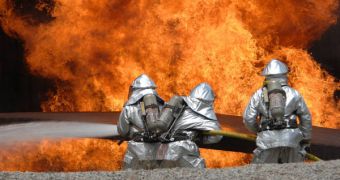According to a paper published in the March 19th issue of the journal Obesity, more than three quarters of all firefighter and paramedic candidates in Massachusetts are either obese or overweight, a situation that repeats itself throughout the country. Obviously, the case is unacceptable, and it's not a matter of discrimination. The thing is that the people in charge of rescuing citizens from burning cars and twisted trains have to have the ability to move very fast and to get to the disaster site on time. Obviously, physical limitations prevent obese individuals from doing that, despite their best intentions.
This line of though applies to firefighters, police officers and ambulance personnel, who always have to be in mint physical condition in order to be able to keep up with their strenuous jobs. If they are obese, then the first thing they will experience when running after a bad guy will be almost-instant fatigue, as well as breathing difficulties and other similar conditions.
Fit law-enforcement officials can run faster and longer than their overweight colleagues, which increases their chances of catching the perpetrators and, eventually, the security of the entire community. Over the past few years, as the obesity epidemic has spread across the US, emergency agencies have no longer had a pool of healthy and fit American youth from which to choose, but rather one of obese and overweight youngsters. This situation leaves officials without any alternative.
A team of scientists from the Boston University School of Medicine, the Boston Medical Center, the Harvard University, and the Cambridge Health Alliance has analyzed a group of 370 recruits. Individuals over the age of 35 or those who failed their services' minimum criteria have been excluded from the research, so that it could focus only on newly employed young people.
The results have shown that only 22 percent of them have been physically fit enough to act as police officers, firefighters or ambulance personnel, while 43.8 percent have been overweight to some degree. But almost 33 percent have been obese, which is an occurrence that was never met in these agencies in the 1980s and the 1990s.
“These findings are strong evidence against the common misconception in the emergency responder community that many of their members have BMIs [body/mass indexes] in the overweight and obese ranges simply on the basis of increased muscle mass. Even in these young recruits, we documented a very strong association between excess BMI and an increased cardiovascular risk profile,” the senior author of the new study, Harvard Medical School assistant professor Dr. Stefanos Kales, explains. He is also the director of the Harvard School of Public Health Occupational & Environmental Medicine Residency.
“Sudden incapacitation during duty puts these emergency responders, as well as their colleagues and the public, in danger. In addition to the dangers posed to public safety, these findings have important economic implications, as state and federal legislation exists for the awarding of benefits to emergency responders who die or are disabled by cardiovascular events, malignancies and work-related orthopedic problems; and the risk of all of these are increased by obesity,” Kales concludes.

 14 DAY TRIAL //
14 DAY TRIAL //